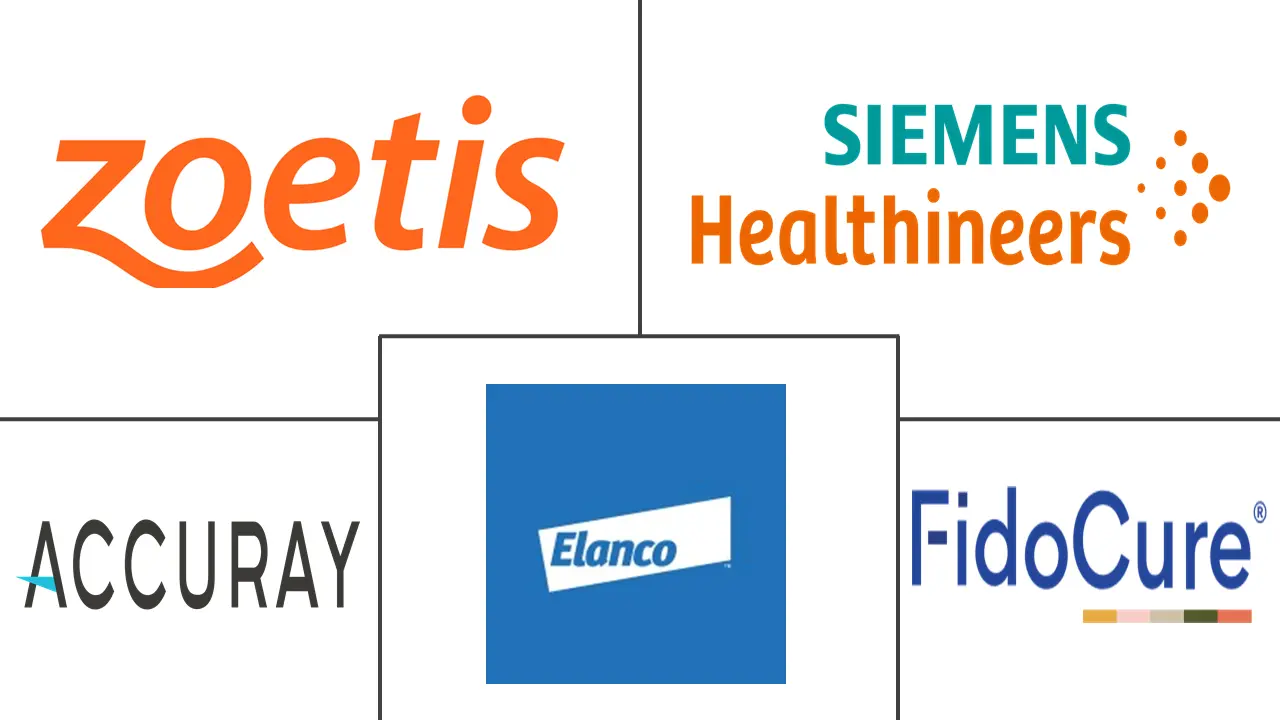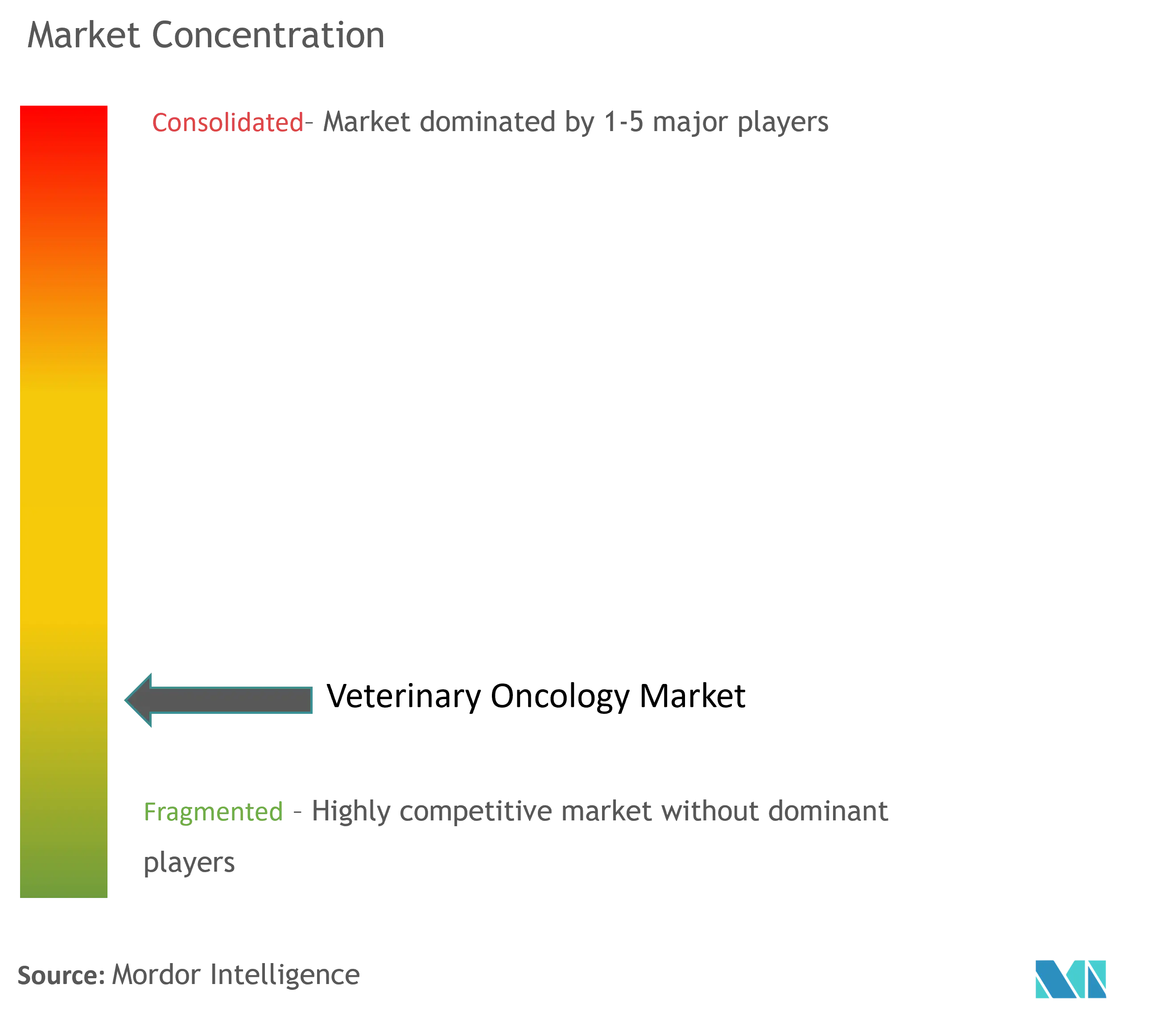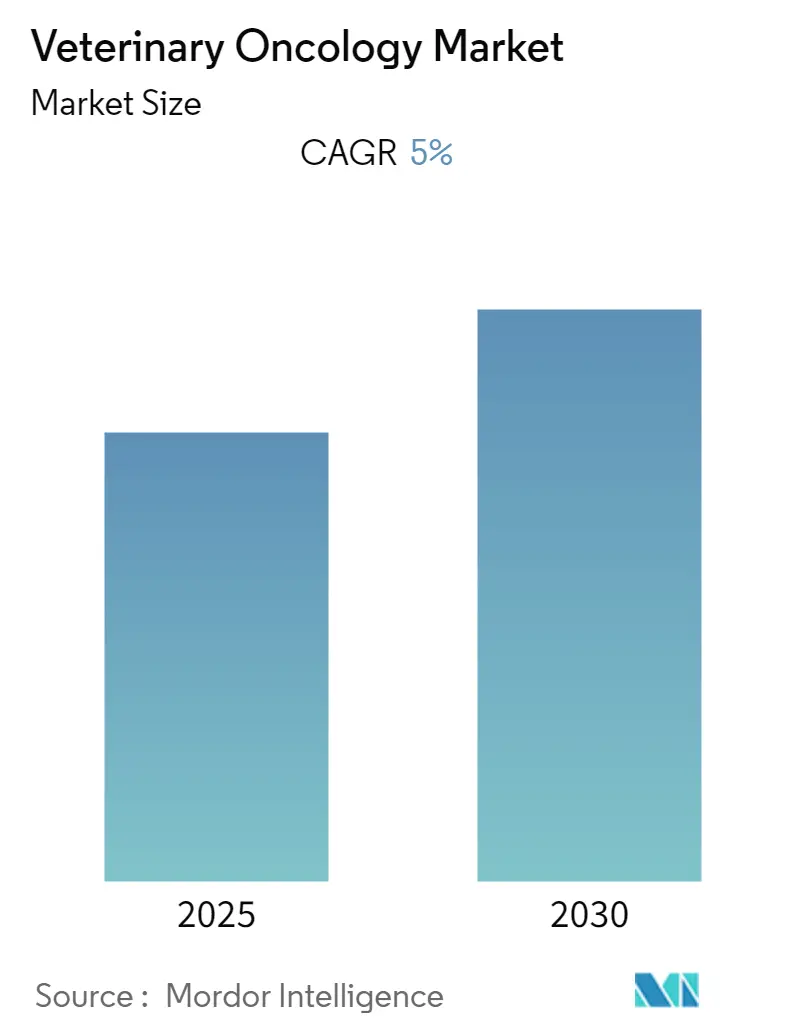
Veterinary Oncology Market Analysis
The Veterinary Oncology Market is expected to register a CAGR of 5% during the forecast period.
Factors such as the rising prevalence of cancer in animals, increasing investments in research and development in the area of veterinary oncology, and growing veterinary healthcare expenditure are expected to drive market growth.
As the burden of cancer cases in animals increases, the demand for effective and advanced therapeutics for cancer treatment is also expected to rise, driving growth in the market studied. For instance, according to a research study published in Aging and Cancer in February 2022, it was estimated that one in four dogs would be diagnosed with cancer in their lifetime. Cancer is the leading cause of death in pets beyond middle age. Therefore, due to the high prevalence of cancer among animals such as dogs, the demand for therapeutics is expected to increase, driving growth in the market studied.
Moreover, the increasing veterinary healthcare expenditure, growing adoption of pet health insurance, and rising research and development activities for the development of effective therapeutics, coupled with new investments, are further expected to augment the growth of the veterinary oncology market during the forecast period. For instance, in January 2024, the Morris Animal Foundation unveiled its latest cohort of eight grant recipients. These researchers are poised to drive forward the Foundation's mission of enhancing the quality of life for canines battling cancer through innovative research endeavors.
The growing burden of cancer in pets is expected to increase demand for veterinary oncology drugs over the forecast period. For instance, according to Kansas City Veterinary Medical Association’s data in July 2022, purebred dogs were 1.9 times more likely to develop cancer than non-purebred dogs in 2022. Thus, the significant burden of cancer in dogs is expected to boost the market over the forecast period.
Moreover, strategic activities by market players, such as funding initiatives, are expected to contribute to market growth over the forecast period. For instance, in November 2022, UW School of Veterinary Medicine received a grant of USD 75,000 to offer life-saving cancer care to pets and their families. The grant was to be distributed on a first-come, first-served basis of up to USD 4,000 per client. Additionally, in May 2022, Jaguar Health launched the Canine Cancer: Take C.H.A.R.G.E. (Canine Health And Registry Exchange). It is a national canine cancer registry that aims to provide the veterinary community and dog owners with vital incidence and prevalence data to aid in the diagnosis and treatment decisions of canine cancer.
Thus, the growing burden of cancer in pets and strategic initiatives taken by the government and market players are expected to contribute to the segment’s growth over the forecast period. However, the high costs associated with cancer treatment and the lack of awareness about veterinary diseases among pet owners are factors that may restrain the growth of the veterinary oncology market during the forecast period.
Veterinary Oncology Market Trends
Canine Animal Type Segment Expected to Hold a Significant Market Share Over the Forecast Period
The canine animal segment is poised to dominate the veterinary oncology market, driven by the high incidence of cancer in canines, growing pet adoption rates, and longer lifespans of these animals, which increase the likelihood of cancer.
Cancer is the leading cause of death in dogs, largely because many cases are diagnosed at advanced stages when the prognosis is unfavorable and clinical symptoms have emerged. For instance, in June 2022, a Frontiers article reported on a study in Mainland China, which found that canine mammary tumors were the most prevalent type of tumors in dogs, accounting for 46.71% of cases in the past five years, with 48.41% of the tumors being benign and 51.59% being malignant, and pure breeds accounting for 84.13% of cases. Therefore, the increasing incidence of tumors in dogs is anticipated to further drive growth in this segment.
Additionally, the increasing number of clinical trials, product approvals, and new therapeutics launches are expected to bolster the growth of the segment. For instance, in August 2023, the Bernese Mountain Dog Club of America funded a study evaluating novel treatment for histiocytic sarcoma. This study aimed to evaluate the potential of a cancer drug to control tumor growth and improve outcomes for dogs with histiocytic sarcoma, an aggressive and typically fatal canine cancer.
Thus, all aforementioned factors, such as the growing burden of cancer in the canine population and strategic activities by market players, are expected to contribute to segment growth over the forecast period.
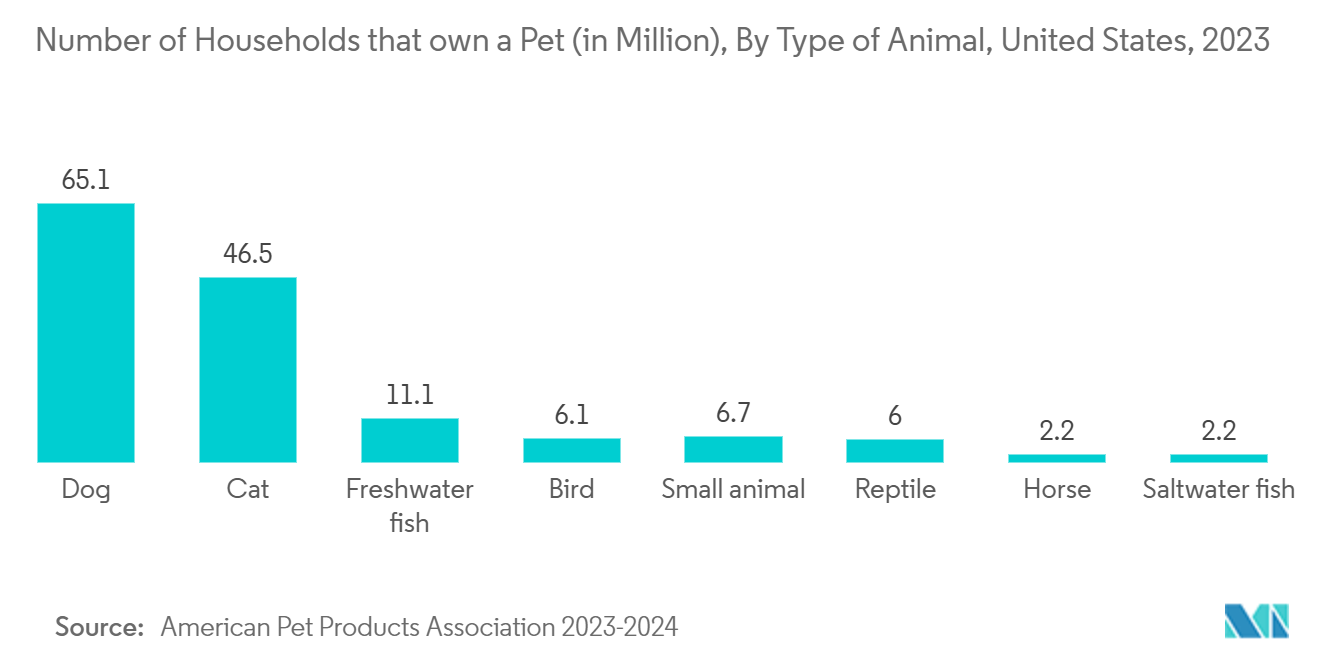
North America Expected to Hold a Significant Market Share Over the Forecast Period
The veterinary oncology market in North America has held a significant share over the years. This trend is expected to continue during the forecast period. This can be attributed to several factors, such as the large animal population, including pets, increasing cancer burden, the presence of better veterinary care and services, and rising veterinary healthcare expenditure in the region.
The growing pet population and its adoption are expected to increase the attention toward pet health, which is likely to contribute to market growth over the forecast period. For instance, according to data from the Canadian Animal Health Institute (CAHI) in September 2022, more than half of Canadian households (60%) owned at least one dog or cat in 2022. Additionally, the dog population increased to 7.9 million, and the cat population increased to 8.5 million in the same year. With such a large animal population, the burden of cancer among animals is expected to be higher, which is likely to drive the growth of the veterinary oncology market.
In North America, the United States is expected to hold a significant share of the veterinary oncology market due to having one of the highest numbers of animals in the region, coupled with high animal health expenditure and a high burden of animal cancer cases. According to the 2023-2024 American Pet Product Association’s (APPA) National Pet Owners Survey, about 66% of households in the United States owned a pet, which translated to about 86.9 million homes. Cats and dogs were the major pets, with total populations of 45.3 million and 69 million, respectively.
Furthermore, pet owners in the United States spend significantly on veterinary care. They spend about USD 458 for dogs and USD 201 for cats for surgical vet visits, and for routine vet visits, they spent USD 242 and USD 178 for dogs and cats, respectively. This indicates the significant presence of a large pet population in the country and the high cost of their healthcare needs. With the growing burden of cancer in the country, research for animal cancer care is increasing, which is expected to augment the growth of the veterinary oncology market. For instance, in November 2022, NCI-funded canine immunotherapy clinical trials were conducted.
Considering all of these factors, the veterinary oncology market is expected to grow significantly during the forecast period in North America.
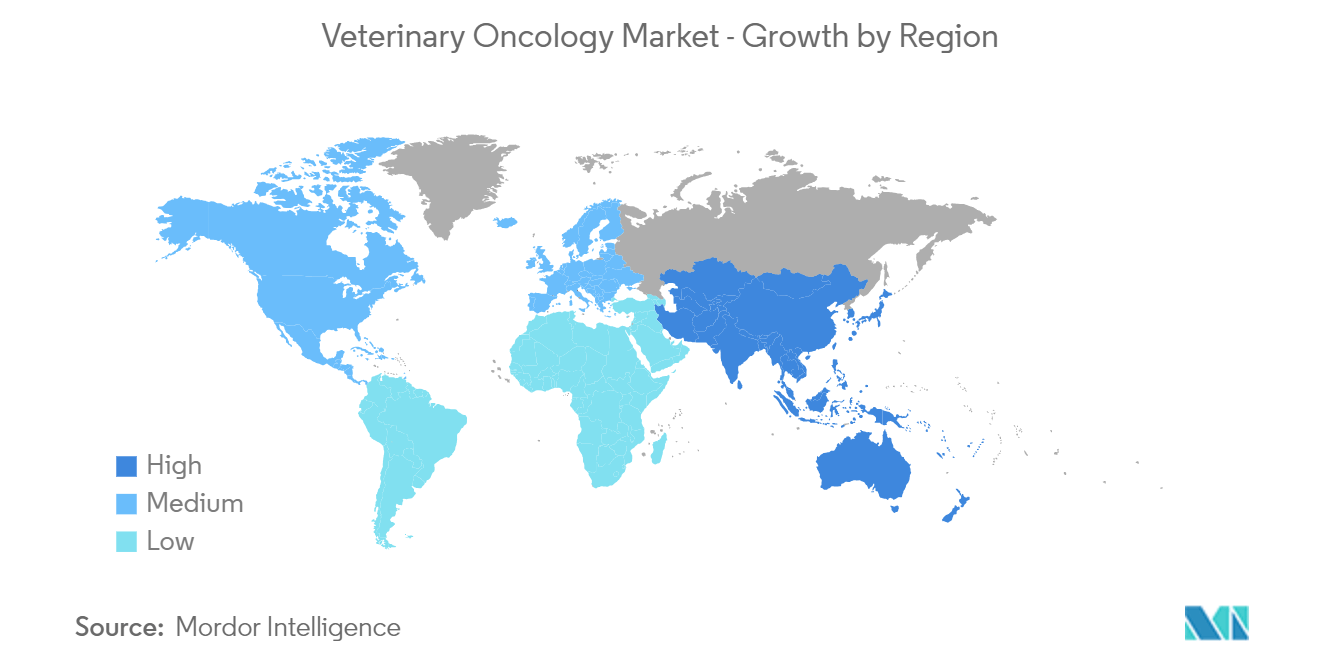
Veterinary Oncology Industry Overview
The market is moderately fragmented, with several companies operating. The veterinary oncology market is currently experiencing growing interest in cancer therapeutics, and as a result, major companies are directing their focus toward developing and introducing new products. Some of the prominent players in the market include Elanco, Zoetis, Siemens Healthineers (Varian Medical Systems), and Accuray Incorporated.
Veterinary Oncology Market Leaders
-
Elanco
-
Zoetis
-
Siemens Healthineers (Varian Medical Systems)
-
Accuray Incorporated
-
OHC (One Health Company)
- *Disclaimer: Major Players sorted in no particular order
Veterinary Oncology Market News
- January 2024: ELIAS Animal Health announced that the US Department of Agriculture’s Center for Veterinary Biologics had determined that the data from the company's ECI-OSA-04 pivotal combined safety and efficacy study demonstrated a reasonable expectation of efficacy, a critical milestone in the licensure pathway in canine cancer.
- October 2023: Merck Animal Health, known as MSD Animal Health outside of the United States and Canada, a division of Merck & Co. Inc., announced that its canonized monoclonal antibody gilvetmab (gil-VET-mab) was now available to veterinary specialists practicing oncology across the United States.
Veterinary Oncology Industry Segmentation
As per the scope of the report, cancer therapies are drugs that block the growth and proliferation of cancer by interfering with specific molecules, such as DNA or proteins, which are involved in the growth or expansion of cancerous cells. These therapies include surgery, radiation therapy, chemotherapy, and immunotherapy. The report includes revenue for cancer therapies provided to animals.
The veterinary oncology market is segmented by treatment type, animal type, application, and geography. By treatment type, the market is segmented into radiotherapy, surgery, chemotherapy, and other treatment types. By animal type, the market is segmented into canine, feline, and other animal types. By application, the market is segmented into lymphoma cancer, mast cell cancer, mammary and squamous cell cancer, and other applications. By geography, the market is segmented into North America, Europe, Asia-Pacific, the Middle East and Africa, and South America. The report also covers the estimated market sizes and trends for 17 countries across major regions globally.
The report offers the market sizes and forecasts in value (USD) for the above segments.
| By Treatment Type | Radiotherapy | ||
| Surgery | |||
| Chemotherapy | |||
| Other Treatment Types | |||
| By Animal Type | Canine | ||
| Feline | |||
| Other Animal Types | |||
| By Application | Lymphoma Cancer | ||
| Mast Cell Cancer | |||
| Mammary and Squamous Cell Cancer | |||
| Other Applications | |||
| Geography | North America | United States | |
| Canada | |||
| Mexico | |||
| Europe | Germany | ||
| United Kingdom | |||
| France | |||
| Spain | |||
| Italy | |||
| Rest of Europe | |||
| Asia-Pacific | China | ||
| Japan | |||
| India | |||
| Australia | |||
| South Korea | |||
| Rest of Asia-Pacific | |||
| Middle East and Africa | GCC | ||
| South Africa | |||
| Rest of Middle East and Africa | |||
| South America | Brazil | ||
| Argentina | |||
| Rest of South America | |||
Veterinary Oncology Market Research FAQs
What is the current Veterinary Oncology Market size?
The Veterinary Oncology Market is projected to register a CAGR of 5% during the forecast period (2025-2030)
Who are the key players in Veterinary Oncology Market?
Elanco, Zoetis, Siemens Healthineers (Varian Medical Systems), Accuray Incorporated and OHC (One Health Company) are the major companies operating in the Veterinary Oncology Market.
Which is the fastest growing region in Veterinary Oncology Market?
Asia-Pacific is estimated to grow at the highest CAGR over the forecast period (2025-2030).
Which region has the biggest share in Veterinary Oncology Market?
In 2025, the North America accounts for the largest market share in Veterinary Oncology Market.
What years does this Veterinary Oncology Market cover?
The report covers the Veterinary Oncology Market historical market size for years: 2019, 2020, 2021, 2022, 2023 and 2024. The report also forecasts the Veterinary Oncology Market size for years: 2025, 2026, 2027, 2028, 2029 and 2030.
Our Best Selling Reports
Veterinary Oncology Industry Report
Statistics for the 2025 Veterinary Oncology market share, size and revenue growth rate, created by Mordor Intelligence™ Industry Reports. Veterinary Oncology analysis includes a market forecast outlook for 2025 to 2030 and historical overview. Get a sample of this industry analysis as a free report PDF download.

